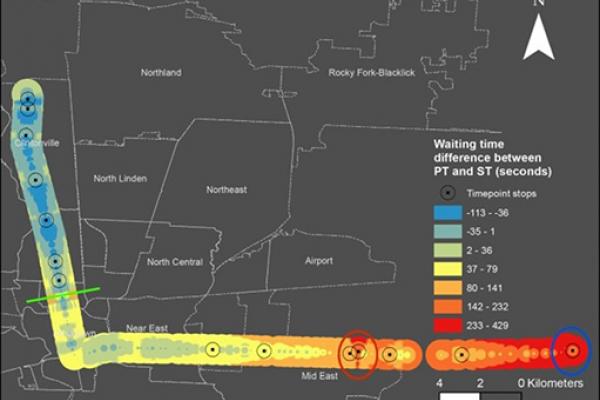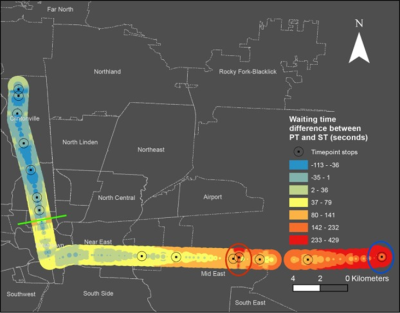Does real-time transit information reduce waiting time? Probably not

By: Luyu Liu, Harvey J. Miller
Background
A common belief about real-time information (RTI) is the reduction of waiting time by allowing passengers to appropriately time their arrivals at transit stops. However, we find that this may not always hold true after investigating real-time transit data for one year (2018 - 2019) in the bus system of the Central Ohio Transit Authority (COTA) in Columbus, Ohio. We theorize and validate two sources of RTI-based users’ waiting time penalties: bus drivers compensating for being behind schedule and discrepancies between RTI updates and reality. We benchmark four typical common strategies for both RTI and non-RTI users and calculate their average waiting time and risk of missing a bus.
Results
Our results do not support the claims that RTI can always reduce waiting time.
- A risky strategy used many transit planning algorithms, which expects people to arrive at the same time as the bus, has the longest waiting time (12 minutes). Its waiting time is even longer than showing up at the stop randomly (8.5 minutes).
- Including a short time buffer before the suggested time by the naïve RTI strategy can significantly reduce waiting time and missing risk.
- We developed an optimized RTI-based strategy and its performance (4.7 minutes) is significantly better than the original naïve RTI-based strategy.
- However, the optimized strategy still has worse general performance than following the schedule (4.2 minutes). Instead, real-time information can only reduce waiting time for some users (area of blue colors) based on location and time as shown in the graph.

Implications
This study provides valuable insights for transit users, planners, public transit agencies, and real-time transit app providers. Our results suggest that real-time performance data under the risky algorithm design is not sufficient: more public transit agencies and RTI apps should also consider historical data to gauge the veracity of the RTI in reducing waiting time based on spatial and temporal context. Users should also have the option of specifying different trip planning strategy, including prudent strategies with pre-calculated optimal time buffers. The techniques and measure we develop in this paper can help support a more holistic and sensitive approach to public transit RTI.
Check out the full academic article in the link below!
